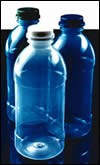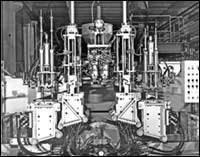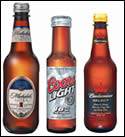No. 9 - Stretch-Blow Molding
Biaxial orientation makes plastic bottles clearer, stronger, lighter, and less permeable to moisture and gases.
Biaxial orientation makes plastic bottles clearer, stronger, lighter, and less permeable to moisture and gases. Without those property enhancements , it is unlikely that plastic bottles would have made such pervasive inroads in replacing glass.
It all began with polypropylene. The early PP orientation systems started with extrusion (or coextrusion for barrier properties) of a tube. The Phillips Orbet process, developed in the late 1960s, involved cutting the tube, pinching one end closed and then stretching and blowing. That method vied with processes developed by Hercules and Bekum for blowing bottles from a continuously extruded tube.
In 1975, Phillips licensed the Orbet technology to Beloit Corp. of Dalton, Mass., which produced the Bi-Axomat stretch-blow machine. The Dawn detergent bottle in 1967 was one of the first domestic applications made on a Bekum machine. In 1974, Hercules used its own process to begin producing PP bottles at a plant in Terre Haute, Ind. It had plans to expand capacity in ’75 to 100 million bottles/yr. However, none of those OPP bottle technologies achieved the hoped-for market penetration on a broad scale. Many times since then, industry pundits have hailed the resurgence of oriented PP bottles—as recently as last year—but it’s still too early to say that they have arrived in force.
The big breakthrough
In the early 1970s, famed DuPont researcher Nathaniel Wyeth made a huge discovery that would pave the way for the development of the oriented PET bottle. Wyeth’s process, which was patented May 15, 1973, involved molding a PET preform and then reheating, stretching, and blowing it into a bottle. Known today as stretch-blow molding, the process has become synonymous with the production of PET bottles. In the U.S. alone, approximately 18 billion bottles were stretch-blown in 2004, mostly for carbonated soft drinks and water.
During the time of Wyeth’s invention, when anticipation was growing that plastic bottles would break into the huge market for carbonated soft drinks, Monsanto was working with Coca-Cola on development of injection stretch-blown styrene-acrylonitrile bottles. Three Monsanto plants came on line in 1975 to produce the 32-oz Lopac bottles, however, the FDA ruled in 1977 that the material was unsafe, leaving the field wide open to the PET bottles championed by DuPont.
While Wyeth’s invention utilized PET preforms that were compression molded, today’s PET preforms are injection molded in both one-stage and two-stage (reheat) machine systems. DuPont pursued commercialization of PET by teaming up with Cincinnati Milacron and Pep si. Milacron developed the first two-stage (reheat-type) stretch-blow ma chine, called the RHB5, introduced in 1976. Bill Geiser of Broadway Mold in Dayton, Ohio, had developed the mold for the first PET preform in 1973.
These developments culminated in the 1977 introduction of the first PET beverage bottle, a 64-oz Pepsi container with a separately injection molded PE base cup. (Later, bottles with integral feet were developed to eliminate the base cup, which added cost and required separation for recycling.) That first bottle was molded by Amoco in Seymour, Ind. The first non-beverage PET bottle was for Scope mouthwash (46 oz), produced by Amoco in 1979.
Milacron dominated the machine market for PET bottles throughout the 1980s. The one-step machine made its appearance in the U.S. in 1976 when Nissei of Japan sold three ASB machines to International Beverage Co. of Chicago for production of 64-oz and 1-liter Pepsi bottles.
Numerous other companies entered the machinery market—some of them only temporarily—including Johnson Controls (now part of Uniloy Milacron), Van Dorn, and Jomar in the U.S.; Husky and W. Amsler of Canada; Sidel of France; Bekum, Corpoplast, and Krones of Germany; Automa, Magic, and Sipa of Italy; Aoki of Japan; Mag-Plastic of Switzerland; and Urola of Spain.
The next big breakthrough for PET is expected to be barrier bottles for beer, juices, teas, wine, and liquid foods.
PVC had its day
In the mid-’70s, at about the same time as the PET bottle revolution was brewing, both injection and extrusion stretch-blow processes were developing in Europe for PVC in applications like water and vegetable oil. Major proponents were Bekum, Battenfeld Fischer, and Kautex. Automa and Nissei ASB also fielded PVC stretch-blow machinery. Production rates got up to more than 3000 bottles/hr in 1986, but oriented PVC caught on mainly in Europe, not in the U.S. Ultimately, PVC was shouldered aside by the PET onslaught.
Read Next
Barrier Bottle Technologies Square Off
With single-serve containers raising shelf-life demands, packagers are seeking the barrier with the best cost-performance for PET bottles. Multilayer seems to have the upper hand, but monolayer, coating, and oxygen-scavenger technologies have all won niches.
Read MoreOPP Bottles: Has Their Time Come?
Maybe this time the often-predicted breakthrough will actually occur. What could make the difference are improved resins, clarifiers, and machinery.
Read More



















.png;maxWidth=300;quality=90)


